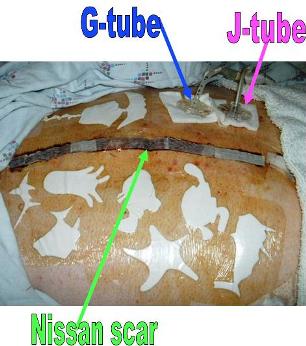

What is a G-Tube? (More info: What is a G-tube?)
Gastrostomy (gastro = stomach,
stoma = opening, -y = procedure/method)
is the name for the procedure to place
a feeding tube into the stomach. The feeding tube is called as the Gastrostomy
tube,
or commonly the G-tube. There are several types of feeding tubes, the most
commonly used are the PEG and the Mic-Key button. These tubes are the means of
providing nutrition directly into the stomach via a tube through the stomach
wall.
Their use can be either to support a person who is unable to take in sufficient
calories by mouth or in some cases to completely remove the need for food
or fluid by mouth.

What is a J-Tube? (More Info: J-tube Placement)
A j-tube is a feeding tube which is
inserted
into the patient's Jejunum (small intestine). The j-tube provides patients who
cannot eat an option for nutrition which is generally safer than IV nutrition.
There are three options in which the tube can be placed.

What is a Nissen/Fundoplication
(spelt "Nissan" above)?
(More Info:
Fundoplication surgery for gastroesophageal reflux disease)
During fundoplication surgery, the
upper curve of the stomach (the fundus)
is wrapped around the esophagus and sewn into place so that the lower portion of
the esophagus passes through a small tunnel of stomach muscle. This surgery
strengthens
the valve between the esophagus and stomach (lower esophageal sphincter, or
LES),
which stops acid from backing up into the esophagus as easily. This allows the
esophagus to heal.
Nissen scar two weeks after surgery.
Granulation Tissue (More
Info:
Granulation Tissue)
The term granulation tissue is derived from the appearance of small, red,
granular foci which bleed easily,
commonly seen within freshly healing tissue. These can be readily demonstrated
in
the base of skin wounds when the overlying scab is picked off. The granulations
consist of clusters of fragile newly-formed capillary blood vessels which
proliferate and grow into damaged tissue along with fibroblasts at an early
stage
of the repair process.
How to treat Granulation Tissue
(Source: Trial and Error)
The best thing that causes NO pain is tea tree oil. Take a gauze or split gauze
if you have it....
soak it in 2 to 4 drops of tea tree oil* and 5cc
water. Place the gauze around the tube closest to the
skin/granulation. Leave it on wet and replace twice a day at least for now.
I guarantee it will help get rid of the granulation.
I have had it several times now, and tea tree oil has gotten rid of it
WITHOUT silver nitrate. We swear by it and so does
Dr. Bethel!
Another non traditional way to
treat granulation tissue is with Ciprodex* ear
drops.
Take a gauze or split gauze if you have it....Place the gauze around the tube
closest to the skin/granulation. Put 4 drops of Ciprodex under the gauze
directly on the
granulation. We use 4 drops twice a day until it is healed.
To read more information about my 9th grade hospital journey, please click here!!!
For more information on
reasons for and types of g-tubes visit:
http://www.cincinnatichildrens.org/health/info/abdomen/home/g-tube-care.htm
*Please consult a physician before using any information stated on this website or any other!*